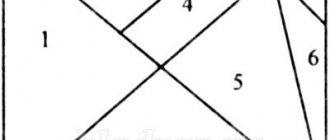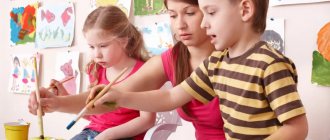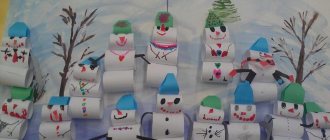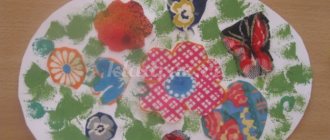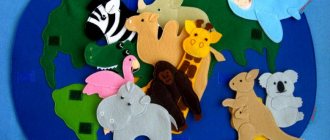Summary of the mathematics lesson “Meter. Table of length measures", 2nd grade. School of Russia
Math lesson “Meter.
Table of length measures" (2nd grade of Federal State Educational Standard). UMK: “School of Russia” Teacher: Margarita Valerievna Usova, MOU Novoberezovskaya secondary school named after Markidonov Basic textbook: UMK “School of Russia” Mathematics 2nd grade M.I.Moro. Lesson type: Lesson on introducing new material. Objectives: to introduce students to the unit of measurement of length - the meter; form a visual representation of the meter; develop the ability to convert one unit of measurement into another; improve computational and problem-solving skills. Planned results: Subject:
- get acquainted with the unit of measurement of length - the meter;
- compare named numbers, solve problems of the studied types; - develop numeracy skills. Meta-subject:
- understand and accept the learning task set by the teacher at different stages of learning;
— search for the necessary information, perform a comparison operation, draw conclusions and clearly present them; - highlight known knowledge and skills from the topic of the lesson. Personal:
- show motivation for educational and cognitive activity and the personal meaning of learning, which are based on the need to constantly expand knowledge to solve new educational problems and on interest in mathematics.
Equipment: Measuring tools: rulers, meter ruler, centimeter, decimeter, meter models
Lesson progress
I. Organizational point. The bell rang and fell silent, our lesson has begun. Take your pens in your hands and write the number beautifully. You write carefully, so that everyone would be pleased to look at your notebook. II. Consolidating knowledge of numbering numbers within 100. Each student receives a sheet with the task:
• Color the fish as follows: red – a fish with a number between 70 and 90; blue - a fish with a number preceding the number 51; yellow – a fish with a number following the number 69; green – a fish with a number that is between the numbers 25 and 50. • Circle the fish with the highest number in brown, and the one with the lowest number in green. Mathematical dictation. • Find the difference between the numbers 45 and 20 (25). • The first term is 35, the second is 15. Find the value of the sum (50). • How much is 43 greater than 30? (By 13) • The minuend is 30, the subtrahend is 16. Find the difference (14). • Find the sum of the numbers 28 and 12 (40). (Answers appear on the slide: 25, 50,13, 14, 40 Well done! Arrange these numbers in ascending order Slide (13,14,25,40,50) III. Calligraphic minute. Grandfather Ignat said to his neighbor: “I’m already a hundred years old.” for dinner!" "You added 30 years!" the neighbor objected to him. Please, guys, count how many years Ignat lived. (70) - Let's write these numbers beautifully and neatly in a notebook: 7 .... 7 .... 7 .... 7 .... 7 0 .... 0 .... 0 .... 0 ....0 – Write down all two-digit numbers using the numbers 4, 7, 0. (40, 44, 47, 70, 74, 77.) IV. Updating knowledge 1 cm .... 1 kg ... 1 dm ... 1 mm ... 1 l (Cards on the board) - How to call in one word everything that is written on the board? (Units of measurement) - What two units do you think are extra here? (1 kg and 1 l) - Why? (A kilogram is a unit of mass and a liter is a unit of volume) - What quantity are the remaining quantities used to measure? (Lengths) - Place the cards with the quantities in ascending order (millimeter, centimeter, decimeter) - Let's fill out the chart: 1 cm=…..mm 1 dm=…cm=….mm. Images on the board: caterpillar, crocodile, beetle


We recommend watching:
Math lesson notes for 2nd grade. Reinforcing addition and subtraction within 100 Notes of a mathematics lesson for children with disabilities in a correctional school, 2nd grade Notes of a mathematics lesson in 2nd grade on the topic “Journey to the winter forest” Mental arithmetic in mathematics lessons in 2nd and 4th grades
Similar articles:
Summary of a 2nd grade math lesson on the topic: Line. Parallel lines
Summary of a 2nd grade math lesson on the topic: Addition and subtraction of two-digit numbers
Summary of a 2nd grade mathematics lesson on the topic: Reciprocal operations
Summary of a mathematics lesson for grade 2 according to the program of L. V. Zankov
Summary of an open lesson in mathematics in grade 2
(First lesson)Program content
Learn to determine the volume of bulk solids using a conventional measure. Measure the length (of the tape) using a conventional measure.
Material for the lesson
The teacher has a bowl of rice (no more than eight glasses), a glass (conventional measure), and a set of cubes.
Progress of the lesson
The teacher puts cubes on the table and asks them to count them. The children are counting.
Teacher
. How many cubes are there in total?
Children
. Ten.
The teacher puts a bowl of rice on the table. Shows the children that there is rice in the bowl and asks: “How can you find out how much rice there is?” The children answer.
If the children's answers are incorrect, the teacher shows the glass and asks if it is possible to use the glass to find out how much rice there is. The children answer in the affirmative.
Teacher
. Let's try to count how many glasses of rice there are.
She calls the child to the table, offers to start measuring the rice, draws the children’s attention to the fact that the measure - the glass - must be full.
A glass of rice is poured into another bowl, and the child puts a cube on the table so as not to get confused when counting: there are as many glasses of rice as there are cubes.
Next, the teacher calls other children. Children count in the same way until they have counted all the rice. The teacher and the children are counting the cubes - there are eight of them.
Teacher
. How much rice is there?
Children
. Eight glasses of rice.
The teacher makes sure that when children name the number of measures, they must indicate the name of the material being measured (for example, eight glasses of rice).
Teacher
. We measured and counted how much rice there was. To make it easier for you to count, you placed a cube, pouring out a glass of rice. Then you will remember and you won’t have to play dice. (The teacher takes out a tape.) How can you measure this tape? (Children answer.)
Can I measure the tape with this? (Shows a strip of cardboard.) How will you measure?
The called child shows. The teacher makes sure that when measuring the tape, the parts are equal to the given measurement, and each measured piece of tape is marked with a cube.
At the end of the lesson, the teacher asks: “What did we do with you?” Summarizing the answers, he sums it up: “We measured the rice and the length of the ribbon. They found out that there were eight glasses of rice and a strip of cardboard was placed eight times in the tape.”
Second lesson
Program content
Learn to determine the volume of granular and liquid bodies using a conventional measure. Show the relationship between magnitude, measure, number.
Material for the lesson
The teacher has a bowl of rice (with no more than ten glasses), a glass (conventional measure), a spoon (conventional measure), a set of cubes, a decanter of water, a cup (conventional measure), a small glass.
Children have a glass of rice (the amount of rice is the same in all), tablespoons (conventional measure), chips (geometric figures).
Progress of the lesson
The teacher invites the children to remember what they did in the last lesson. Children must answer that they measured the cereal with a glass, which they called a measuring stick.
The teacher continues: “On my table there is cereal and two objects - a glass and a spoon. What do these two things have in common?” Children must answer that both objects can be a measure.
After this, the teacher shows how to pour it into a spoon so that it is a measure. She emphasizes that the fullness of the measure should be the same.
The teacher pours a spoonful of cereal into a saucer and asks: “What did you and I do so as not to forget how many spoons of cereal were poured?”
Children must remember that they placed cubes for this. The teacher shows a jar of water. He asks how you can measure water in a jar. Listens to the children's answers and clarifies that the cup in this case will be the measuring stick. Then the teacher begins to measure how many cups of water are in the jar and invites the children, after pouring a cup of water, to place a cube in order to remember better.
The teacher always draws the children's attention to the fact that the cup must be full, otherwise it will not be a measuring stick. It turned out that there were two cups of water in the jar. Next, the teacher says that water can be measured using different standards: a glass, a cup, a spoon. Then she asks: “What can you measure with a strip?” Children answer: “Tape, strip of paper, Tverevka.”
After this, the teacher suggests using a spoon to measure the rice that is on the children’s tables, take out mugs, squares or abacus from the boxes to mark how many spoons of rice have been poured.
The children begin to work: measure out the rice and, pouring a spoon, place a square or circle.
The teacher looks at who has poured how many spoons of rice (three spoons of rice were poured into the glasses). He asks after everyone has finished working: “Who got three spoons of rice?”
The children answer. The teacher says that everyone had three spoons of rice.
If the children get a different number of spoons of rice, the teacher explains why the mistake occurred and emphasizes that the measure - the spoon - must be full (“The same as I showed you”).
The teacher invites the children to look at the table and remember how many cups of water were in the jar. The children answer. Then she shows a small glass. “What do you think, if we measure water with a glass, the number of glasses will be more than cups or less?”
Children answer: “More” - and explain why.
After this, the teacher measures out the water in a glass, drawing the children’s attention to the fact that the measure is full, and the children place cubes according to the number of glasses. The teacher asks the children to say how many glasses of water they got. When children answer, it is important to ensure that they always name the measure after the number, for example, nine glasses of water.
Third lesson
Program content
Teach children to measure the length and width of objects (tables) using a conventional measure
Repeat the number series; know the previous and next number 1? number line, game "Neighbors".
Material for the lesson
The teacher has tape, strips of paper or cardboard (conventional measurements).
For children - strips of paper (measurements), rectangular sheets of paper, geometric figures (chips).
Progress of the lesson
There are various objects on the table (a glass, a spoon, a strip of cardboard, etc.). The teacher asks the children to remember what they did in the last lesson. Children must answer: “Measured” or: “Measured.”
After this, the teacher asks what the objects lying on the table can be called. Children's expected answer: "Measurements."
The teacher shows the children the tape and asks them to measure it. Children choose a strip of cardboard from the conventional measurements lying on the table.
After measuring the tape, the teacher measures the table top. The teacher shows that it is more convenient to measure along the edge of the table (so that the measure does not move), and teaches the children to notice the place where the end of the measure was in order to put it further away from it.
Then the teacher asks to measure the length and width of the sheets of paper lying on the children’s tables. Children are given pre-prepared measurements. For convenience, the teacher suggests marking with chips how many times the measure was met.
After the measurement, the teacher invites the children to play the game “Neighbors”. Children lay out a row of number cards on tables. The teacher calls the number. Children must put forward two cards on their tables and explain why they are neighbors of the named number.
Fourth lesson
Program content
To consolidate children's knowledge about measurement and conventional measures. Show the dependence of the number of measures on the size of the measure when the quantity being measured does not change.
Repeat the number series, game “Name the missing number”.
Material for the lesson
The teacher has cereal in a plate, water in a jar, measurements (large glass, small glass, spoon, string, cubes).
Children have chips, sets of numbers.
Progress of the lesson
The teacher invites the children to remember what they did in previous classes.
Children answer: “Measured” or: “Measured.” The teacher points to the table where various measurements are located and asks: “What can you call all these objects?” Children's answer: “Measurements.”
“Can everything be measured by the same standards?” the teacher clarifies. The children answer: “No.” The teacher asks: “How can you measure cereals? How to measure the table? What to measure with a glass?
The teacher invites one of the children to come to the table, choose a measure and measure how much cereal is in the plate. Children complete the task. After this, the teacher asks to take a larger (smaller) measure and measure the cereal in the plate again (the amount of cereal is the same).
Children count. The measure fits fewer (or more) times. The teacher asks: “Why did the second measurement fit fewer (or more) times?” Children must answer that the measure was larger (or smaller). The teacher shows a jar of water and asks how you can measure water. Children name glass, cup, spoon.
Teacher: “Think, if I measure water with a glass and a spoon, in which case will the measure fit more times and why?” The children answer.
In conclusion, the teacher invites the children to lay out a number series of numbers on the tables and plays the game “Name the Missing Number.”

